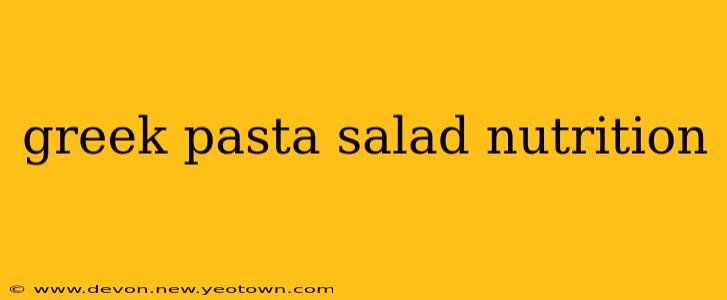The vibrant colors and refreshing taste of Greek pasta salad make it a summertime staple. But beyond its deliciousness, lies a nutritional profile that's worth exploring. This isn't just a simple side dish; it's a potential powerhouse of vitamins, minerals, and healthy fats, depending on how you prepare it. Let's delve into the nutritional aspects of this beloved salad and uncover its secrets.
What are the main ingredients in Greek pasta salad and their nutritional benefits?
The classic Greek pasta salad typically features rotini or other short pasta, ripe tomatoes, cucumbers, Kalamata olives, red onion, feta cheese, and a lemon-herb vinaigrette. Each ingredient contributes unique nutritional value:
- Pasta: Provides carbohydrates for energy. Choosing whole wheat pasta boosts fiber content, promoting digestive health and satiety.
- Tomatoes: Packed with lycopene, a powerful antioxidant linked to reduced cancer risk. They also offer vitamin C and potassium.
- Cucumbers: Low in calories and high in water content, contributing to hydration. They also provide some vitamin K.
- Kalamata Olives: A source of healthy monounsaturated fats, which can benefit heart health. They also contain antioxidants.
- Red Onion: Adds a pungent flavor and offers beneficial compounds like quercetin, an antioxidant with anti-inflammatory properties.
- Feta Cheese: A source of protein and calcium, essential for bone health. However, it's also higher in sodium and fat compared to other cheeses.
- Lemon-Herb Vinaigrette: The olive oil in the vinaigrette provides healthy fats, while the lemon juice adds vitamin C and a bright, tangy flavor. Fresh herbs like oregano and parsley contribute additional antioxidants and flavor.
How many calories are in a serving of Greek pasta salad?
The calorie count of Greek pasta salad varies significantly depending on the ingredients and portion size. A typical serving (around 1.5 cups) can range from 250 to 400 calories. Factors influencing calorie count include:
- Type of pasta: Whole wheat pasta will generally be slightly higher in calories than refined pasta.
- Amount of feta cheese: Feta is relatively high in fat and calories. Using less will lower the overall calorie count.
- Type of dressing: Creamy dressings add significantly more calories than lighter vinaigrette dressings.
Is Greek pasta salad a healthy meal option?
Greek pasta salad can be a healthy meal option, but it depends on how it's prepared. A salad made with whole wheat pasta, plenty of vegetables, a light vinaigrette, and a moderate amount of feta cheese offers a good balance of carbohydrates, protein, healthy fats, and fiber. However, a version laden with refined pasta, excessive feta, and a creamy dressing becomes significantly less healthy, becoming higher in calories, saturated fat, and sodium.
What are some healthy variations of Greek pasta salad?
To make your Greek pasta salad even healthier, consider these variations:
- Boost the veggies: Add more vegetables like bell peppers, zucchini, or artichoke hearts to increase the nutrient density.
- Choose whole wheat pasta: This will increase the fiber content, promoting better digestion and satiety.
- Reduce the feta: Use less feta cheese or substitute some with a lower-fat cheese option.
- Make your own dressing: Control the ingredients and reduce the added sugars and unhealthy fats by making your own vinaigrette with olive oil, lemon juice, and herbs.
- Add protein: Include grilled chicken, chickpeas, or lentils for added protein and fiber.
Can I make a low-carb version of Greek pasta salad?
Yes, a low-carb version is achievable by substituting the pasta. Zucchini noodles (zoodles), shirataki noodles, or cauliflower rice can effectively replace pasta, drastically reducing the carbohydrate content. Remember to adjust the seasoning to complement the new texture and flavor profile.
Greek pasta salad, when made thoughtfully, can be a delicious and nutritious part of a balanced diet. By paying attention to the ingredients and making smart substitutions, you can enjoy this summer classic guilt-free! Remember, moderation and mindful preparation are key to maximizing its health benefits.

